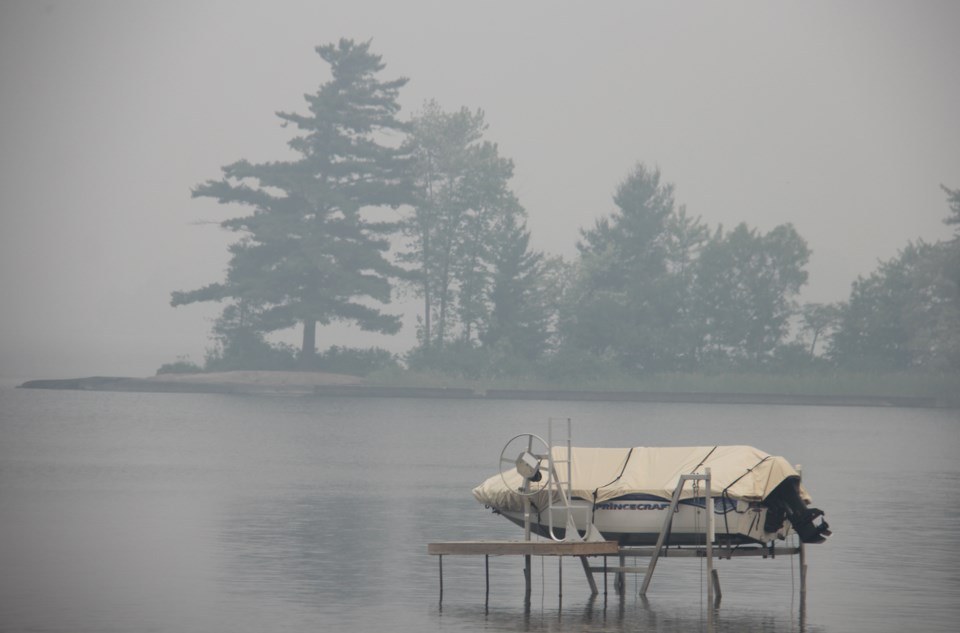The air quality index for the North Bay area has reached dangerous levels this morning, and you should avoid outside exposure if possible.
BayToday has installed an air quality sensor at its downtown office. You can check the real-time readings here.
At one point this morning the index stood a 519, which is at the top of the chart. For comparison, an AQI of 100 is the upper end of the “Moderate” range, and the level above at-risk groups should start exercising caution.
Above 300 indicates a health warning of emergency conditions and everyone, not just those at risk, is more likely to be affected with 24 hours of exposure.
Sudbury is presently at 355, Pembroke 403.
East Ferris has cancelled its Canada Day and St. Jean Babtiste Day celebrations today due to poor air quality.
The Municipality issued a notice on its Facebook page earlier this morning, and Municipal staff confirmed today's event is cancelled.
Fine particulate matter (PM2.5) is an air pollutant that is a concern for people's health when levels in the air are this high. PM2.5 are tiny particles in the air that reduce visibility and cause the air to appear hazy when levels are elevated.
They are so small that they can be inhaled and cause serious health problems. Some particles less than 10 micrometers in diameter can get deep into your lungs and some may even get into your bloodstream.
PM2.5, particles pose the greatest risk to health.
Short-term exposures (up to 24-hours duration) have been associated with premature mortality, increased hospital admissions for heart or lung causes, acute and chronic bronchitis, asthma attacks, emergency room visits, respiratory symptoms, and restricted activity days.
These mostly affect infants, children, and older adults with preexisting heart or lung diseases.
Environment Canada has issued a special statement on air quality in the North Bay area because high levels of air pollution have developed due to smoke from forest fires.
Stop outdoor activities and contact your healthcare provider if you or someone in your care experiences shortness of breath, wheezing (including asthma attacks), severe cough, dizziness, or chest pains. Stay inside if you are feeling unwell and experiencing symptoms. Keep your indoor air clean. Keep your doors and windows closed if the temperature in your home is comfortable. Use an air purifier with a High Efficiency Particulate Air (HEPA) filter in a room where you spend a lot of time. Avoid air purifiers that produce ozone.
Milder and more common symptoms of smoke exposure include:
- sore and watery eyes
- runny nose and sinus irritation
- scratchy throat and mild coughing
- headache
The following symptoms are less common, but are more serious:
- shortness of breath
- wheezing (including asthma attacks)
- severe cough
- dizziness
- chest pains
- heart palpitations
Research about wildfire smoke exposure has shown increased risks for low birth rate and preterm labour including high blood pressure, breathing challenges, and parental stress. If you're pregnant and having a hard time breathing well in poor air quality, your baby's breathing could be affected as well.
The Health Unit recommends:
- Avoid frying food and using smoke-producing appliances such as wood stoves, candles and incense.
- Don't smoke tobacco inside. Smoking puts added stress on your lungs and those around you.
- Hold off on vacuuming, unless your vacuum is equipped with a high efficiency particulate air (HEPA) filter. Settled dust can be removed by wiping and wet mopping after a wildfire event.
- Think carefully before using cleaning products. Refrain from using any that could improperly give off high levels of volatile organic compounds (VOCs).
- Prevent outside air from getting in by:
- properly sealing windows and doors and keeping them closed
- installing a high-quality air filter to remove particulate matter from the incoming air, in homes with forced air ventilation.
- if you have an HVAC system in your home, use the highest rated MERV filter for your system (ideally rated 13 or higher) and set the fan to recirculate air constantly. You can also use a portable High Efficiency Particulate Air (HEPA) air cleaner.
There are currently 28 active wildland fires in the northeast region. Of these, 15 are not under control, 6 are being held, 6 fires are under control and 1 is being observed.
The fire hazard is high to extreme across the vast majority of the northeast region again today,
A restricted fire zone remains in effect for the entire fire region of Ontario. Outdoor fires are banned.
